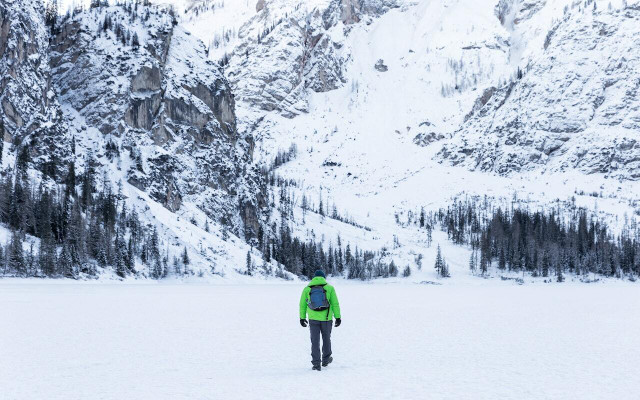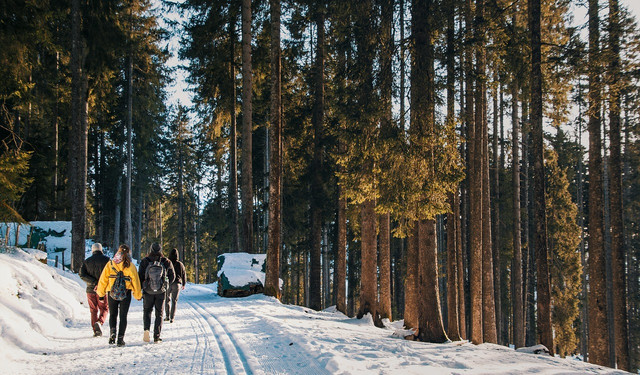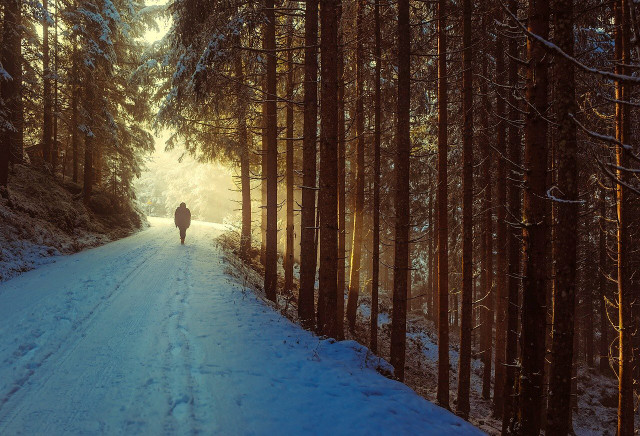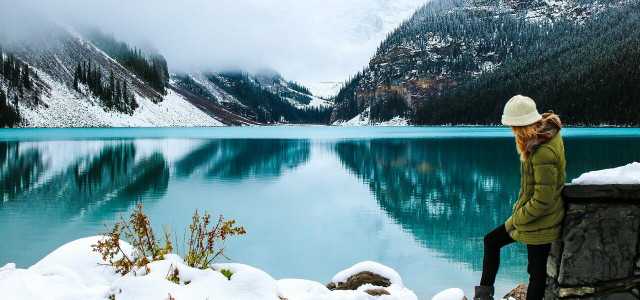Hiking in winter means you can avoid the summer hiking crowds and enjoy the views without the heat. Here we explain some tips to help make your next winter hike safe and warm.
As the days get shorter and the temperatures get colder, it can be difficult to motivate yourself to go outside and get some proper exercise, but being active can help beat bad moods, fix your sleep schedule, and reduce stress. Hiking in winter has its own set of challenges you need to keep in mind, but with the right equipment and precautions, you can enjoy the outdoors all year round.
What to Do Before Hiking in Winter

(Foto: CC0 / Unsplash / Riccardo Chiarini)
Do your research
Knowing what type of terrain and conditions you will face on your chosen hike is a vital part of prepping beforehand. Quiet forest hikes and windswept coastal wanderings for a couple of hours will look a lot different from a strenuous day-long mountain hike, so you will need to adapt your gear and plans accordingly. Most national parks and reserves will have their own websites, complete with maps and suggested trails for hikers, so use the resources available to you.
Pay attention to weather warnings
Winter weather conditions can range from pretty mild to extreme, depending on which area of the country you live in. No matter what, keeping up-to-date on weather forecasts when hiking in winter is an absolute must. This will not only make your hike safer and more comfortable, but it also gives you a good idea of what you need to pack.
Stick to what you know
Depending on your age, fitness level, and previous hiking experience, it’s a good idea to start small. Stick to what you know you can handle in terms of your own physical capabilities instead of biting off more than you can chew. You don’t need to overdo it, remember that hiking in winter is ultimately meant to be enjoyable – it’s more about the journey than the destination.
Start early, finish early
This is another safety tip worth remembering. When hiking in the winter, there are fewer hours of daylight, so setting off early and finishing early allows you to make the most of what little sun there is. It also means that if your hike takes longer than expected, you don’t end up exposing yourself to unnecessary risk by hiking back in the dark.
What to Pack When Hiking in Winter



(Foto: CC0 / Pixabay / lukasbieri)
Always take the proper gear
Aside from a durable backpack that fits properly, you’ll need waterproof, cold-weather clothing and comfortable shoes or hiking boots. It is always good to write a list and check things off as you go for the smaller, forgettable items. Each hike is going to be different, but certain items are always a good idea:
- Sun protection (sunscreen, sunglasses, homemade lip balm)
- Band-aids
- Fresh socks to help keep your feet warm
- Spare batteries or chargers for electronic gear
- Warm gloves, a knit beanie and a scarf
- Compass, map, and/or GPS
Also interesting: Running in Snow: 7 Great Tips for Winter Running
Take plenty of refreshments and snack foods
Along with warm winter clothing, packing various nutritious snacks for the trail and plenty of fluids is part of the fun. Hiking in winter can dehydrate you just as much as a summer hike, so a good water supply is a good idea. There’s no greater treat on a colder winter hike than a flask full of homemade hot cocoa. Try making 3-ingredient energy bars or homemade granola bars to take with you. Non-GMO fresh or dried fruits, nuts, and organic trail mix are also good staples to include and will give you that boost if you start to lose steam on the trail.
More Winter Hiking Tips to Keep You Safe
Let others know when and where you are going to hike
It’s important at any time of the year, but especially when hiking in winter. Let family or friends know of your hiking plans, where exactly you are going, who you are traveling with and how long you expect to be away. When done responsibly, most hikes are fairly low-risk, but it pays to have a backup just in case something goes awry on the trail.
Stay on the trail
Aside from maintaining your safety in unfamiliar, sometimes dangerous terrain, sticking to the hiking trails at all times will ensure you don’t get lost and keep you from trampling on rare plants or disturbing local wildlife. Signage is not always reliable in less-maintained hiking areas, so a map and compass are a must in any case.
Tread Lightly to Protect the Environment



(Foto: CC0 / Pixabay / 12019)
The most important thing when hiking in winter (or at any time of the year) is to leave as little impact on the environment as possible. Again that means things like staying on the trail to avoid disturbing rare or fragile plants and animals nearby, getting the right permits and sticking to the rules that will apply when hiking in our national reserves, packing your food and drinks in reusable containers to reduce plastic waste and taking your litter with you and dispose of it responsibly.
It’s easy to do your part, which will aid in protecting these new outdoor experiences for yourself and others to enjoy. These handy seven principles of Leave No Trace sum it up nicely:
- Plan Ahead and Prepare
- Travel and Camp on Durable Surfaces
- Dispose of Waste Properly
- Leave What You Find
- Minimize Campfire Impacts
- Respect Wildlife
- Be Considerate of Other Visitors
Read more:
- 10 Best Hikes Near NYC You Can Reach by Train
- Wild Camping: A Beginner’s Guide to Free Camping in the US & Canada
- Zero Waste Travel: Green Living On The Road
Important Information regarding Health-related Topics.
** Links to retailers marked with ** or underlined orange are partially partner links: If you buy here, you actively support Utopia.org, because we will receive a small part of the sales proceeds. More info.Do you like this post?








